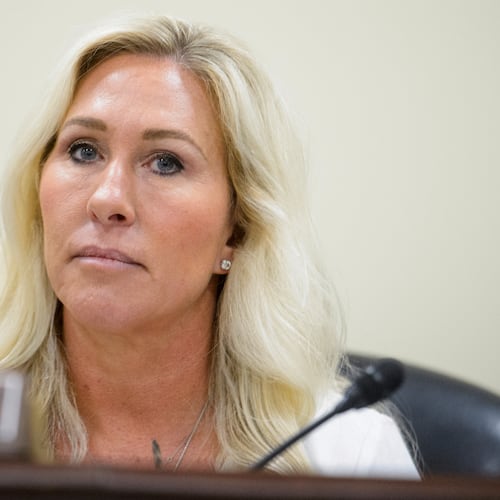David Ralston in 2002 campaigned across his soon-to-be Georgia House district with a map, trying to make sure he was in the right place.
A year earlier Statehouse Democrats had redrawn political district lines in oddly shaped, sometimes elongated ways to combat a growing Republican threat to their General Assembly majority. They paired dozens of GOP lawmakers in some districts to force them to run against each other and drew others to strengthen the position of Democrats. One county of 9,500 people was split into four House districts. The new district maps were described as Picassos, or, using Waffle House parlance, “scattered, smothered and covered.”
So Ralston traveled with his son and a map to make sure the voters he connected with were in the five-county district he hoped to represent. And the Blue Ridge Republican said he learned a valuable lesson from that redistricting session that the GOP today shouldn’t forget.
Democrats lost the Senate in 2002, and then the House in 2004, after a judge redrew the district lines.
“I learned you can push the envelope way too far, and I think that is what the other party did that year,” said Ralston, now speaker of the Georgia House.
Now Ralston’s Republicans are the ones trying to retain power as the political ground shifts beneath their feet.
“This year, I basically told (Republican) members there are real dangers and risks associated with trying to use this process to try to grow our numbers with the population shifts as they have been,” he said.
That 2001 redistricting session has become a sort of rallying cry for Republicans, a “what-about-what-you-did” retort any time Democrats utter accusations of gerrymandering during this month’s ongoing redistricting session.
“There is a direct correlation to 2001,” said Rep. Calvin Smyre, D-Columbus, who was the House majority caucus chairman that year. “The situation is much more difficult when you are doing reapportionment and the (political) pendulum is swinging because of the uncertainties, and it’s like you are going into uncharted waters.”
Losing voters
Georgia has gained about 1 million people since 2010. Virtually all the growth is in urban and suburban areas, and the nonwhite population continued to expand while the white population declined. White, rural Georgia, a major power base for Republicans, lost population. It’s been losing people for decades, but rural white lawmakers — first conservative Democrats, then Republicans — have retained a strong grip on power in the General Assembly.
Every decade, following the census, lawmakers gather to redraw political boundaries for state House, Senate and congressional districts, as they are doing now. They do it because each House seat has to have the same number of Georgians. The same with each Senate and congressional seat.
How those lines are drawn — creating districts that have more Republican or Democratic voters — can determine which party runs the General Assembly for years to come.
It is the most inherently political thing lawmakers do during a session. For General Assembly districts, they are essentially picking their own voters ... or at least the House and Senate leaders are doing it for them. Since Republicans have a majority, the district maps that they want win passage.
This session started two weeks ago and House and Senate maps moved quickly through the chambers, too fast for Democrats, who said they’ve been rushed with little chance for the public to have a say.
While Democrat Joe Biden won the state in last year’s presidential election, and Georgia elected two Democratic U.S. senators, those were the party’s first big statewide wins in decades. Democrats have called, unsuccessfully, for maps that are more evenly split based on the close 2018 and 2020 elections.
Under the new House map, the chamber’s Republican majority could lose as many as six seats after next year’s elections. The map creates 97 districts that lean Republican and 83 that trend toward Democrats, according to an analysis by The Atlanta Journal-Constitution. There are currently 103 Republicans and 77 Democrats in the House.
In the Senate, where Republicans hold a 34-22 advantage, the map has 33 districts that lean Republican, 23 that lean toward Democrats.
The maps appear to acknowledge the loss of rural population by increasing seats in more diverse, Democratic-leaning urban and suburban areas. They pit some lawmakers against each other in the same district or put them into seats that will be difficult to win in 2022, but that happens in most redistricting sessions.
“Our focus was on making sure we did it properly,” said Senate Majority Leader Mike Dugan. R-Carrollton.
Some lawmakers say the General Assembly maps could have been worse for Democrats, considering the GOP’s desire to hold onto power throughout the 2020s.
But Democrats who spoke in floor debates last week also said the districts should have been crafted in a way that kept more communities unified under one representative and empowered people of color to represent them. Members of the House are about 67% white in a state where white people make up about half the population.
“Republicans have ignored the will of Georgia voters in drawing their Statehouse map proposal. It minimizes the political power of the people of Georgia and ignores the fact that Georgia is equally divided politically,” said Rep. Carolyn Hugley, a Democrat from Columbus who was first elected in 1992.
Georgia freshman Sen. Michelle Au, D-Johns Creek, who was drawn into a Republican-leaning district, said: “This map does not reflect the Georgia of today. This map does not reflect who we’ve become. And this map is not what voters asked for.”
The General Assembly hasn’t yet taken up congressional district maps, which will be contentious because the Republican majority will almost certainly seek to pick up one or two seats currently held by Democrats. Republicans hold eight of Georgia’s 14 congressional seats after losing districts in 2018 and 2020 in parts of Atlanta’s northern suburbs that were once Republican strongholds.
Credit: Isaac Sabetai
Credit: Isaac Sabetai
The ghosts of 2001
Earlier this month, Sen. Jeff Mullis, R-Chickamauga, who was first elected in 2000, was having none of it when Democrats in a committee meeting presented their redistricting proposal and talked about the need for fairness. Mullis reminded them of what happened in 2001. There was, he said, no fairness, no attempt to avoid what was described as “revenge gerrymandering” from the majority Democrats then.
Sen. Ed Harbison, D-Columbus, a member of the committee, noted that he voted for those district maps.
“He is absolutely right about political gerrymandering in that era and the karma that resulted from that,” Harbison said. “There was political punishment from it. I was a Democrat and I voted for it during that era, and that doesn’t make it right.”
Charles Bullock, a longtime University of Georgia political scientist who wrote the book “Redistricting: The Most Political Activity in America,” said the 2001 session was different than any other because the governor — Democrat Roy Barnes — was so deeply involved in the process.
Barnes was up for reelection in 2002, and Republicans were gaining fast on Democrats who had run state government since Reconstruction. Republican George W. Bush had outpolled Democrat Al Gore in Georgia by 300,000 votes in the 2000 presidential election.
Bullock said instead of trying to cut their losses, Democrats said, “Let’s take this hand with no cards in it and make a winning hand out of it.
“Those were crazy maps,” he said.
Credit: Special
Credit: Special
The session overlapped with 9/11, when Georgians were a whole lot more concerned with the war on terror than political line-drawing going on in Atlanta.
Democrats spread out Black voters in hopes of giving themselves a chance to win or retain more seats, Bullock said. Multimember districts — where more than one state representative represented an area — were reinstituted a decade after they’d disappeared. About half the House Republicans at the time were paired in the same seat — meaning one of them would lose or not run — or put into Democratic districts. In some cases, Republicans were given a long, snaking district they couldn’t effectively represent.
In a paper on the history of redistricting that he later wrote, Bullock said Democrats defended overpopulating Republican districts and underpopulating Democratic areas as necessary to allow South Georgia and Atlanta to retain more legislators.
Republicans cried foul and ran campaigns in 2002 — particularly in rural Georgia, where counties had been split into multiple districts — on the issue of Democratic gerrymandering. There were many other issues that dominated the campaigns that year — Barnes had pushed through a change in the state flag to minimize the Confederate battle emblem and had battled teachers — but the GOP tried to make redistricting a symbol of one-party control gone bad.
Barnes lost to longtime Democrat-turned-Republican Sen. Sonny Perdue — whose district was torn up in 2001 — and the Senate nearly flipped to the GOP. After the election, Senate Republicans got enough conservative Democrats to switch parties to take over the chamber.
Federal judges threw out the maps, and a retired judge redrew the district lines. When the House map came out in 2004, Democrats walked to the anteroom of the chamber for a peek. Some worried they’d lose the chamber to the Republicans at the next election. By the end of the year, the takeover was complete.
Credit: AJC staff
Credit: AJC staff
“That’s what it is all about in redistricting: who gets what, when and where,” Smyre said. “The pendulum had swung, the trend was going in the other direction, and the state at that time was going in the other direction. That was the situation in 2001, and there is a direct correlation to what is happening today.”
A decade later, in 2011, the Republican majority redrew congressional lines in hopes of growing their numbers and getting rid of U.S. Rep. John Barrow, the lone white Democrat from the Deep South in the U.S. House. The GOP was firmly in control of the General Assembly, and the process, and the Department of Justice approved the Republican-drawn maps.
Bullock said Republican leaders of the General Assembly this year probably looked at the electoral losses they suffered in 2018 and the districts they couldn’t win back in 2020 and decided on a more pragmatic approach.
“They thought, here we are drawing maps in 2021 that will be in place in 2030,” he said. “Let’s cut our losses on the front end and give them the districts we are having a hard time defending already.”
Ralston doesn’t know where it will lead. Lawsuits are typical after redistricting. And demographic changes aren’t going the Republicans’ way as long as much of their base is heavily white and rural. Republicans in his chamber hold 103 of 180 seats, and he hopes to have that many — at least — after the November 2022 elections. But nothing is certain.
“Will we come out of this with more Republicans?” he asked. “Maybe not.”
About the Author
Keep Reading
The Latest
Featured






